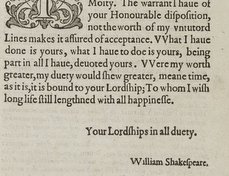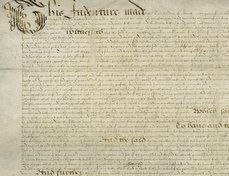Images reproduced by permission of The National Archives, London, England.
Terms of use
The National Archives give no warranty as to the accuracy, completeness or fitness for the purpose of the information provided.
Images may be used only for purposes of research, private study or education. Applications for any other use should be made to The National Archives Image Library, Kew, Richmond, Surrey TW9 4DU, Tel: 020 8392 5225 Fax: 020 8392 5266.
Document-specific information
Creator: Court of Requests
Date: June 30, 1612
Repository: The National Archives, Kew, UK
Call number and opening: REQ 1/26, p. 421
View online bibliographic record
Alan H. Nelson and Folger Shakespeare Library staff, "Bellott v. Mountjoy: Final Order referring the dispute to the French Church in London," Shakespeare Documented, https://doi.org/10.37078/324.
The National Archives, REQ 1/26, page 421. See Shakespeare Documented, https://doi.org/10.37078/324.
Shown here is the third of three orders given by the Court of Requests in Bellott v. Mountjoy. The lawsuit, begun on January 28, 1612, was between Stephen Bellott and Christopher Mountjoy, head of a French Huguenot family living in Silver Street in Cripplegate Ward, just north of Cheapside and St. Paul’s Cathedral. Members of the household included Christopher and Marie Mountjoy, their only child Mary, and Stephen Bellott, an apprentice in the family business, the fabrication of elaborate and fashionable headpieces called “tires.” The lawsuit concerns negotiations which led to the marriage of Stephen and Mary on November 19, 1604. Bellott complains that his father-in-law subsequently reneged on an agreement to support the young couple financially. On May 11, 1612, William Shakespeare deposed as a witness. Depositions in the case reveal that Shakespeare, then a lodger in the Mountjoy household, had been engaged to persuade Bellott to enter the marriage.
This final order refers the dispute to the overseers and elders of the French Church in London.
An entry in the French Church archives dated July 30, 1612, records that the overseers and elders of the Church in London appointed Abraham Hardret and Gedeon de Laune to represent Christpher Mountjoy, Dauid Carperau & Pierre Beauuais to represent Stephen Bellott. A final note asserts that both father-in-law and son-in-law are “desbauchéz” or, in English, debauched, perhaps meaning merely that they had fallen away from faithful attendance at the French Church. Entries in the archives of the French Church in London are transcribed in Charles William Wallace's “Shakespeare and his London Associates” (pages 40-1).
Twenty-six documents survive from Bellott v. Mountjoy. Twelve of these refer to Shakespeare explicitly or implicitly (including one with his signature), although the document shown here does not. The lawsuit is generally unremarkable and Shakespeare’s involvement is minor. However, the case does contribute to our understanding of Shakespeare's life: that in 1604 he was living in Silver Street with a family of French Huguenot tiremakers. In 1909 Charles William Wallace and his wife Hulda Berggren Wallace discovered Bellott v. Mountjoy in the Public Records Office, now The National Archives.
[This transcription is pending final vetting. Transcriptions of Bellott. v. Mountjoy are based on Charles William Wallace, "Shakespeare and his London Associates, As Revealed in Recently Discovered Documents," University of Nebraska Studies, 10 no. 4 (1910), 260-360. This publication has a secondary pagination, followed here for individual entries: pp. 39-40.]]
Tricesimo die Junij Anno predicto./
Bellot
Mountioy
In the matter of varyance brought before the Kinges maiestie and his
highenes Counsaill in his maiesties honorable Court of Whitehall by Stephen
Bellot complainant against Xpofer Mountioy defendant, the said complainant by his
bill seeking to be releived towching A promise supposed by the said
bill to be by him the said defendant Mountioy made for the payment
vnto the said complainant of the somme of threescore poundes or theareaboutes
vpon the day of the said complainantes mariage with Mary Mountioy
daughter of the said defendant & now wief of the complainant, And for
the leaving to the said complainant & Mary his wief the somme of
CCl [£200] more at the tyme of his the said defendantes decease, As in
& by the said bill of complaynt more at lardge appeareth.
Vnto which bill the said defendant appeared & answered, witnesses
on both partes were examined and A day of hearing appoynted.
Vpon opening whereof It is by his maiesties said Counsaill of this
Court in presence of the said parties and of Counsaill learned on
both sydes ordered by and with the full consent of the saide
parties, that the same matter shalbe referred to the hearing
ordering & finall determinacion of the Reverend & grave
overseers and Elders of the french Church in London
aucthorising them hereby to call before them both the saide
parties And vpon consideracion had of the state of the same
cause & the circumstaunces of the same, to heare Order &
finally determine the said matter towching the promise as
to their discrecions & wisdomes shall seeme convenient, And
such order as shalbe herein determined by the said Committees,
this court will confirme establishe & decree./
…
To learn more, read Alan H. Nelson's essay on lawsuits in Shakespeare's England.
Co-written by Folger Shakespeare Library staff and Alan H. Nelson
Sources
Charles William Wallace, "Shakespeare and his London Associates, as Revealed in Recently Discovered Documents" University of Nebraska Studies 10, no. 4 (1910): 39-40.
A full list of sources for Bellott v. Mountjoy is given under Bellott v. Mountjoy: First set of depositions.
Last updated February 1, 2020


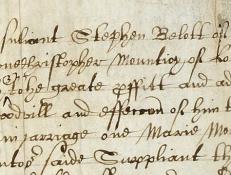
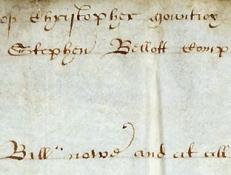
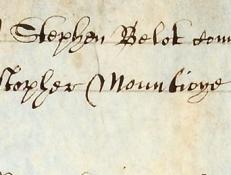
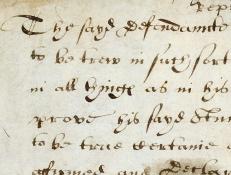
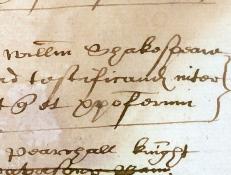

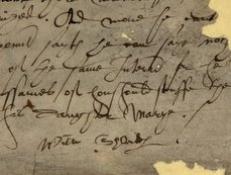
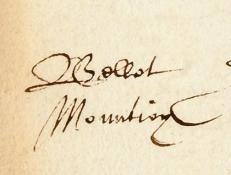
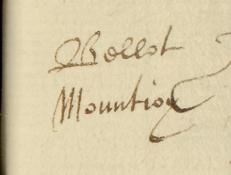
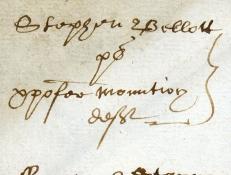
![REQ 4/1/4/2 [1], thumbnail detail](https://shakespearedocumented.folger.edu/sites/default/files/styles/document_thumbnail/public/document-thumbnails/REQ4-1-4-2%20%281%29%20The%20Belott%20v%20Mountjoy%20suit%2C%20deposition%20of%20Daniel%20Nicholas%201612_thumbnail%20detail.jpg?itok=qLDPDvNb)
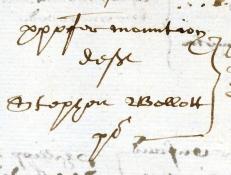
![REQ 4/1/4/3 [1], thumbnail detail](https://shakespearedocumented.folger.edu/sites/default/files/styles/document_thumbnail/public/document-thumbnails/REQ4-1-4-3%20%281%29%20The%20Belott%20v%20Mountjoy%20suit%2C%20deposition%20of%20Christopher%20Weaver%201612_thumbnail%20detail.jpg?itok=CccGcAQB)

